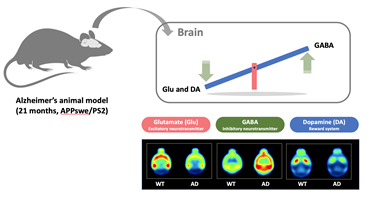글로벌 연구동향
분자영상 및 방사화학
- [Front. Neurosci.] Amyloid pathology induces dysfunction of systemic neurotransmission in aged APPswe/PS2 mice아밀로이드 병리학은 노화된 APPswe/PS2 마우스에서 전신 신경 전달의 기능 장애를 유도한다
KIRAMS / 오세종, 최재용*
- 출처
- Front. Neurosci.
- 등재일
- 2022 05 August
- 저널이슈번호
- 내용
-
Abstract
This study aimed to investigate how amyloid pathology affects the functional aspects of neurotransmitter systems in Alzheimer’s disease. APPswe/PS2 mice (21 months of age) and wild-type (WT) mice underwent positron emission tomography (PET) and magnetic resonance spectroscopy (MRS). First, we obtained 18F-FDG and 18F-florbetaben PET scans to evaluate neuronal integrity and amyloid pathology. Second, 18F-FPEB and 18F-FMZ PET data were acquired to assess the excitatory-inhibitory neurotransmission. Third, to monitor the dopamine system, 18F-fallypride PET was performed. Amyloid PET imaging revealed that radioactivity was higher in the AD group than that in the WT group, which was validated by immunohistochemistry. In the cortical and limbic areas, the AD group showed a 25–27% decrease and 14–35% increase in the glutamatergic and GABAergic systems, respectively. The dopaminergic system in the AD group exhibited a 29% decrease in brain uptake compared with that in the WT group. A reduction in glutamate, N-acetylaspartate, and taurine levels was observed in the AD group using MRS. Our results suggest that dysfunction of the neurotransmitter system is associated with AD pathology. Among the systems, the GABAergic system was prominent, implying that the inhibitory neurotransmission system may be the most vulnerable to AD pathology.

치매 쥐(APPswe/PS2, AD)와 정상쥐 (WT)에서 글루코스, 아밀로이드, 글루타메이트, 가바, 도파만계에 선택적으로 결합하는 방사성의약품을 주사한 후 양전자방출단층촬영술(PET)을 시행한 결과, 치매 쥐에서 억제성 신경전달체계인 가바계의 방사성의약품 섭취가 정상군보다 높았고, 흥분성 및 보상과 관련된 글루타메이트-도파민계는 정상군보다 낮은 뇌흡수를 보였습니다.
Se Jong Oh1, Namhun Lee1, Kyung Rok Nam1, Kyung Jun Kang1, Sang Jin Han1, Kyo Chul Lee1, Yong Jin Lee1 and Jae Yong Choi1,2*
- 연구소개
- 알츠하이머병은 베타 아밀로이드와 과인산 타우 단백질 등 이상 단백질이 뇌 속에 쌓여 정상 뇌 신경세포의 점진적 사멸을 유도하는 퇴행성 뇌질환으로 치매의 가장 흔한 원인입니다. 또한 65세 이상의 연령에서의 유병율이 80% 가 높기 때문에 노인성 질환으로 분류되기도 합니다. 인구 고령화의 가속화와 출산율 저하 등으로 미래 사회의 생산 가능 인구가 급격히 감소할 전망이지만 안타깝게도 아직 치매에 대한 효과적 치료제는 개발되지 않은 상태입니다. 최근 알츠하이머병 환자에서 나타나는 인지기능, 언어 및 성격 장애 등에 대한 임상 증상에 대한 병인으로 신경전달체계에 대한 연구를 진행하고 있습니다. 본 연구에서는 아밀로이드 병리와 당 흡수 등의 기존 연구 방법에 학습과 기억 및 보상과 관련된 신경전달체계에 대한 기능적 변화를 종합적으로 평가고자 하였습니다. 실험 결과, 당대사의 변화를 살펴보는 글루코스 PET에서는 치매군과 대조군 모두 비슷한 수준의 뇌 섭취를 나타내었지만, 흥분성-억제성 신경전달계인 가바-글루타메이트계 및 보상과 관련된 도파민 계에서는 치매 쥐와 정상 쥐 사이에 뇌 섭취의 유의미한 차이를 관찰할 수 있었고, 특히 가바의 변화가 가장 크게 나타남을 확인할 수 있었습니다. 기존 알츠하이머병 치료제들은 인지기능개선을 목적으로 한 콜린성 및 글루타메이트계가 대부분입니다. 하지만 본 연구를 통해 알츠하이머병에서 억제성 신경전달체계의 심각한 손상을 확인할 수 있었으므로, 이를 타겟으로한 치료제 개발 가능성을 제시할 수 있는 생물학적 근거를 마련할 수 있었습니다.
- 덧글달기
- 이전글 [Theranostics] Cerenkov luminescence imaging of interscapular brown adipose tissue using a TSPO-targeting PET probe in the UCP1 ThermoMouse
- 다음글 [Front Vet Sci.] Case Report: 18F-Fluoro-L-Phenylalanine Positron Emission Tomography Findings and Immunoreactivity for L-Type Amino Acid Transporter 1 in a Dog With Meningioma









